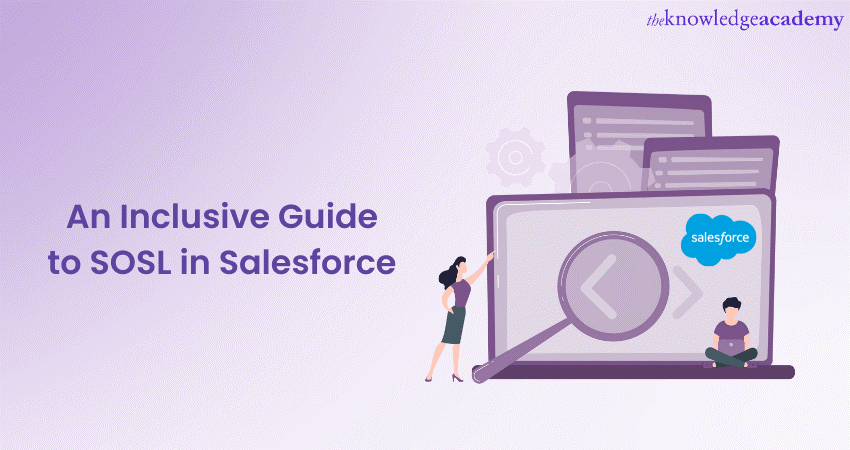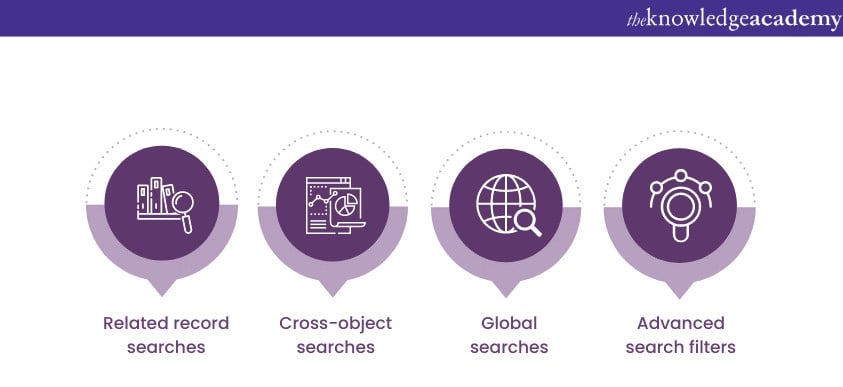We may not have the course you’re looking for. If you enquire or give us a call on +357 26030221 and speak to our training experts, we may still be able to help with your training requirements.
We ensure quality, budget-alignment, and timely delivery by our expert instructors.

Salesforce is a powerful Customer Relationship Management (CRM) platform that provides various tools and functionalities to enhance business processes. One such tool is Salesforce Object Search Language (SOSL), which enables users to perform comprehensive searches across multiple objects in the Salesforce database.
According to a 2023 Statista survey of Salesforce, the company has boosted its market share in CRM systems to 19.5 per cent, four times more than SAP. SOSL simplifies the process of finding relevant records and retrieving valuable information. This blog will explore the key concepts of SOSL in Salesforce and provide practical examples to help you leverage its capabilities efficiently.
Table of Contents
1) Understanding SOSL in Salesforce
2) Working of SOSL queries in Salesforce
a) Example of SOSL queries in Salesforce
3) Practical applications of SOSL in Salesforce
4) Conclusion
Understanding SOSL in Salesforce
Salesforce Object Search Language (SOSL) is a powerful tool in the Salesforce platform that helps users perform comprehensive searches across multiple objects simultaneously. It expands the capabilities of the Salesforce Object Query Language (SOQL), which has the limitation of querying a single object at a time.
Additionally, SOSL simplifies the process of finding relevant records and retrieving valuable information, making it an essential tool for developers to retrieve data efficiently in Salesforce. SOSL basically operates on the concept of search queries. These queries consist of search terms and optional filters, allowing users to construct precise and flexible searches. These search terms can be individual words, phrases, or even wildcard characters like asterisks (*) and question marks (?). This flexibility ensures that SOSL can accommodate various search scenarios, from exact matches to partial or fussy searches.
Furthermore, when constructing SOSL queries, users can specify the fields and objects they want to include in the search. This allows for narrowing down the search scope to retrieve more accurate results. SOSL queries are structured using the FIND keyword followed by the search terms, optional field lists, and object lists. The search results are then ranked based on relevance, helping users prioritise and focus on the most pertinent records.
SOSL supports global searches across all searchable objects in Salesforce. This means you can search for a specific keyword or phrase across multiple records, regardless of the object they belong to. Global searches are beneficial when you need to find information related to a particular topic or theme, enabling you to uncover relevant data across your entire Salesforce instance.

Working on SOSL queries in Salesforce
Constructing effective SOSL queries is essential for leveraging the full potential of Salesforce Object Search Language (SOSL). By understanding the SOSL syntax and the available search features, users can create powerful queries to retrieve accurate and relevant information from multiple objects simultaneously.
The first step in constructing a SOSL query is to identify the search terms. These terms can be individual words, phrases, or even wildcard characters. Carefully selecting the search terms ensures that the query retrieves the desired records.
Next, users can specify the fields and objects to include in the search. By targeting specific fields, such as account names or contact email addresses, users can narrow down the search scope and retrieve more precise results. Including the appropriate objects in the query is crucial for searching across the relevant data entities within Salesforce.
The structure of a SOSL query involves using the FIND keyword followed by the search terms, optional field lists, and a list of Salesforce Objects. These objects, such as Accounts, Contacts, or custom objects, serve as the foundation for specifying where the search should be conducted. This syntax allows users to construct complex queries that cater to specific search requirements. The search results generated by SOSL queries are ranked based on relevance, making it easier to focus on the most significant records.
To further refine SOSL queries, users can incorporate filters. Filters restrict the search to specific criteria, enabling users to retrieve records that meet certain conditions. For example, users can add filters to search for records created within a certain date range or to exclude specific objects from the search results.
Additionally, SOSL queries can include an ORDER BY clause to determine the desired order of the search results. This clause allows users to sort the results based on specific fields, such as date, name, or relevance. Ordering the results helps users prioritise and analyse the retrieved records more effectively.
Constructing SOSL queries also involves considering the use of wildcard characters. Wildcards, such as asterisks (*) and question marks (?), can be utilised to perform partial or fussy searches. This is particularly useful when dealing with incomplete or variable search criteria, allowing for more flexible and inclusive searches.
Example of SOSL queries in Salesforce
SOSL is a search language utilised by developers in Salesforce, to conduct textual searches in database records. The typical syntax for SOSL queries in Salesforce comprises the following key aspects:
1) Fields that can be searched
2) List of required objects and fields
3) Expression-based textual search
4)Criteria for row selection from source objects
An example of a SOSL query that can be executed to search for accounts and contacts with the term ‘SFDC’, would be as follows:
List
Learn to use Salesforce developers’ tools, by signing up for the Salesforce Developer Training Course now!
Practical applications of SOSL in Salesforce
Salesforce Object Search Language (SOSL) offers several practical applications that enhance data retrieval and analysis in the Salesforce platform. Here is a list of key practical applications of SOSL:

1) Related record searches: SOSL allows users to search for records related to a specific entity across multiple objects. For example, you can search for all contacts associated with a particular account or all opportunities linked to a specific lead. This capability provides a holistic view of data relationships and streamlines the process of retrieving interconnected records.
2) Cross-object searches: SOSL enables users to perform searches across multiple objects simultaneously. This is particularly useful when you need to gather information related to a specific keyword or topic from various objects. For instance, you can search for all relevant accounts, contacts, and opportunities associated with a particular product or service, facilitating comprehensive data analysis.
3) Global searches: With SOSL, you can perform global searches across all searchable objects in Salesforce. This allows you to find information related to a specific keyword or phrase across multiple records, regardless of the object they belong to. Global searches provide a broad overview of data and help identify patterns, trends, or commonalities across different entities.
4) Advanced search filters: SOSL queries can incorporate filters to refine search results based on specific criteria. You can add filters to search for records within a particular date range, filter by record owner, or exclude specific objects from the search. These advanced filters enable users to narrow down search results and retrieve more targeted information.
Conclusion
This blog discussed the SOSL tool within Salesforce, equipped with characteristics of versatility and power. Whether you are using it with different Record Types in Salesforce or other custom objects, SOSL helps users perform comprehensive searches across multiple objects. Embracing SOSL enhances productivity and optimises the Salesforce experience for users.
Learn the core concepts and roles of a Salesforce administrator, by signing up for the Salesforce Admin Training Course now!
Frequently Asked Questions
Upcoming Programming & DevOps Resources Batches & Dates
Date
 Salesforce CRM Masterclass
Salesforce CRM Masterclass
Fri 28th Feb 2025
Fri 4th Apr 2025
Fri 27th Jun 2025
Fri 29th Aug 2025
Fri 24th Oct 2025
Fri 5th Dec 2025






 Top Rated Course
Top Rated Course


 If you wish to make any changes to your course, please
If you wish to make any changes to your course, please


